Anthony Bagnall
Rock the KASBA: Blazingly Fast and Accurate Time Series Clustering
Nov 26, 2024Abstract:Time series data has become increasingly prevalent across numerous domains, driving a growing demand for time series machine learning techniques. Among these, time series clustering (TSCL) stands out as one of the most popular machine learning tasks. TSCL serves as a powerful exploratory analysis tool and is also employed as a preprocessing step or subroutine for various tasks, including anomaly detection, segmentation, and classification. The most popular TSCL algorithms are either fast (in terms of run time) but perform poorly on benchmark problems, or perform well on benchmarks but scale poorly. We present a new TSCL algorithm, the $k$-means (K) accelerated (A) Stochastic subgradient (S) Barycentre (B) Average (A) (KASBA) clustering algorithm. KASBA is a $k$-means clustering algorithm that uses the Move-Split-Merge (MSM) elastic distance at all stages of clustering, applies a randomised stochastic subgradient gradient descent to find barycentre centroids, links each stage of clustering to accelerate convergence and exploits the metric property of MSM distance to avoid a large proportion of distance calculations. It is a versatile and scalable clusterer designed for real-world TSCL applications. It allows practitioners to balance run time and clustering performance. We demonstrate through extensive experimentation that KASBA produces significantly better clustering than the faster state of the art clusterers and is offers orders of magnitude improvement in run time over the most performant $k$-means alternatives.
On time series clustering with k-means
Oct 18, 2024Abstract:There is a long history of research into time series clustering using distance-based partitional clustering. Many of the most popular algorithms adapt k-means (also known as Lloyd's algorithm) to exploit time dependencies in the data by specifying a time series distance function. However, these algorithms are often presented with k-means configured in various ways, altering key parameters such as the initialisation strategy. This variability makes it difficult to compare studies because k-means is known to be highly sensitive to its configuration. To address this, we propose a standard Lloyd's-based model for TSCL that adopts an end-to-end approach, incorporating a specialised distance function not only in the assignment step but also in the initialisation and stopping criteria. By doing so, we create a unified structure for comparing seven popular Lloyd's-based TSCL algorithms. This common framework enables us to more easily attribute differences in clustering performance to the distance function itself, rather than variations in the k-means configuration.
aeon: a Python toolkit for learning from time series
Jun 20, 2024Abstract:aeon is a unified Python 3 library for all machine learning tasks involving time series. The package contains modules for time series forecasting, classification, extrinsic regression and clustering, as well as a variety of utilities, transformations and distance measures designed for time series data. aeon also has a number of experimental modules for tasks such as anomaly detection, similarity search and segmentation. aeon follows the scikit-learn API as much as possible to help new users and enable easy integration of aeon estimators with useful tools such as model selection and pipelines. It provides a broad library of time series algorithms, including efficient implementations of the very latest advances in research. Using a system of optional dependencies, aeon integrates a wide variety of packages into a single interface while keeping the core framework with minimal dependencies. The package is distributed under the 3-Clause BSD license and is available at https://github.com/ aeon-toolkit/aeon. This version was submitted to the JMLR journal on 02 Nov 2023 for v0.5.0 of aeon. At the time of this preprint aeon has released v0.9.0, and has had substantial changes.
Convolutional and Deep Learning based techniques for Time Series Ordinal Classification
Jun 16, 2023Abstract:Time Series Classification (TSC) covers the supervised learning problem where input data is provided in the form of series of values observed through repeated measurements over time, and whose objective is to predict the category to which they belong. When the class values are ordinal, classifiers that take this into account can perform better than nominal classifiers. Time Series Ordinal Classification (TSOC) is the field covering this gap, yet unexplored in the literature. There are a wide range of time series problems showing an ordered label structure, and TSC techniques that ignore the order relationship discard useful information. Hence, this paper presents a first benchmarking of TSOC methodologies, exploiting the ordering of the target labels to boost the performance of current TSC state-of-the-art. Both convolutional- and deep learning-based methodologies (among the best performing alternatives for nominal TSC) are adapted for TSOC. For the experiments, a selection of 18 ordinal problems from two well-known archives has been made. In this way, this paper contributes to the establishment of the state-of-the-art in TSOC. The results obtained by ordinal versions are found to be significantly better than current nominal TSC techniques in terms of ordinal performance metrics, outlining the importance of considering the ordering of the labels when dealing with this kind of problems.
Unsupervised Feature Based Algorithms for Time Series Extrinsic Regression
May 02, 2023Abstract:Time Series Extrinsic Regression (TSER) involves using a set of training time series to form a predictive model of a continuous response variable that is not directly related to the regressor series. The TSER archive for comparing algorithms was released in 2022 with 19 problems. We increase the size of this archive to 63 problems and reproduce the previous comparison of baseline algorithms. We then extend the comparison to include a wider range of standard regressors and the latest versions of TSER models used in the previous study. We show that none of the previously evaluated regressors can outperform a regression adaptation of a standard classifier, rotation forest. We introduce two new TSER algorithms developed from related work in time series classification. FreshPRINCE is a pipeline estimator consisting of a transform into a wide range of summary features followed by a rotation forest regressor. DrCIF is a tree ensemble that creates features from summary statistics over random intervals. Our study demonstrates that both algorithms, along with InceptionTime, exhibit significantly better performance compared to the other 18 regressors tested. More importantly, these two proposals (DrCIF and FreshPRINCE) models are the only ones that significantly outperform the standard rotation forest regressor.
Bake off redux: a review and experimental evaluation of recent time series classification algorithms
Apr 25, 2023Abstract:In 2017, a research paper compared 18 Time Series Classification (TSC) algorithms on 85 datasets from the University of California, Riverside (UCR) archive. This study, commonly referred to as a `bake off', identified that only nine algorithms performed significantly better than the Dynamic Time Warping (DTW) and Rotation Forest benchmarks that were used. The study categorised each algorithm by the type of feature they extract from time series data, forming a taxonomy of five main algorithm types. This categorisation of algorithms alongside the provision of code and accessible results for reproducibility has helped fuel an increase in popularity of the TSC field. Over six years have passed since this bake off, the UCR archive has expanded to 112 datasets and there have been a large number of new algorithms proposed. We revisit the bake off, seeing how each of the proposed categories have advanced since the original publication, and evaluate the performance of newer algorithms against the previous best-of-category using an expanded UCR archive. We extend the taxonomy to include three new categories to reflect recent developments. Alongside the originally proposed distance, interval, shapelet, dictionary and hybrid based algorithms, we compare newer convolution and feature based algorithms as well as deep learning approaches. We introduce 30 classification datasets either recently donated to the archive or reformatted to the TSC format, and use these to further evaluate the best performing algorithm from each category. Overall, we find that two recently proposed algorithms, Hydra+MultiROCKET and HIVE-COTEv2, perform significantly better than other approaches on both the current and new TSC problems.
A Review and Evaluation of Elastic Distance Functions for Time Series Clustering
May 30, 2022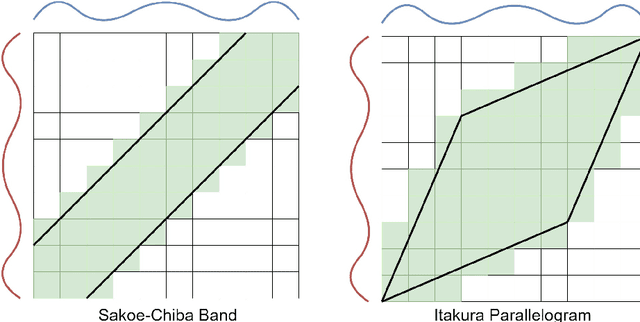
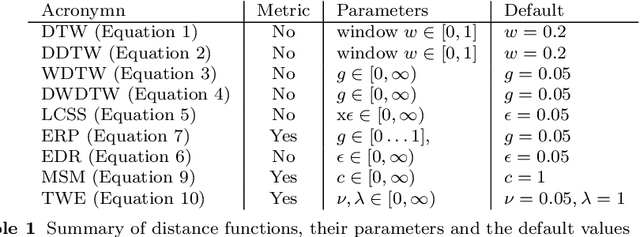
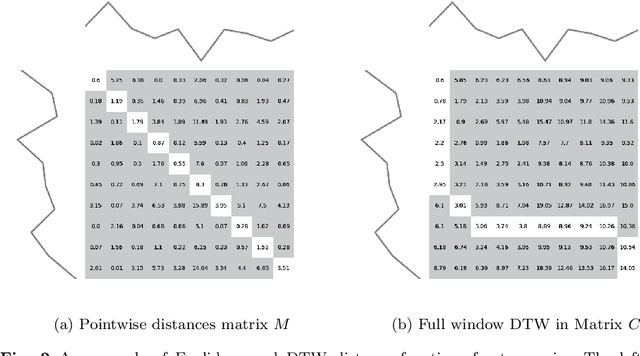
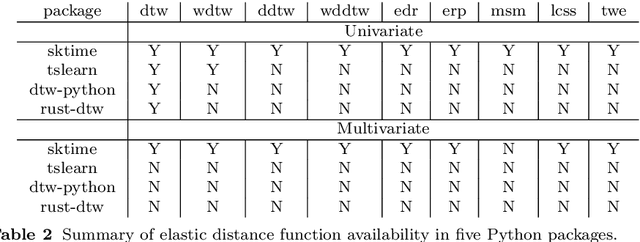
Abstract:Time series clustering is the act of grouping time series data without recourse to a label. Algorithms that cluster time series can be classified into two groups: those that employ a time series specific distance measure; and those that derive features from time series. Both approaches usually rely on traditional clustering algorithms such as $k$-means. Our focus is on distance based time series that employ elastic distance measures, i.e. distances that perform some kind of realignment whilst measuring distance. We describe nine commonly used elastic distance measures and compare their performance with k-means and k-medoids clustering. Our findings are surprising. The most popular technique, dynamic time warping (DTW), performs worse than Euclidean distance with k-means, and even when tuned, is no better. Using k-medoids rather than k-means improved the clusterings for all nine distance measures. DTW is not significantly better than Euclidean distance with k-medoids. Generally, distance measures that employ editing in conjunction with warping perform better, and one distance measure, the move-split-merge (MSM) method, is the best performing measure of this study. We also compare to clustering with DTW using barycentre averaging (DBA). We find that DBA does improve DTW k-means, but that the standard DBA is still worse than using MSM. Our conclusion is to recommend MSM with k-medoids as the benchmark algorithm for clustering time series with elastic distance measures. We provide implementations, results and guidance on reproducing results on the associated GitHub repository.
The FreshPRINCE: A Simple Transformation Based Pipeline Time Series Classifier
Jan 28, 2022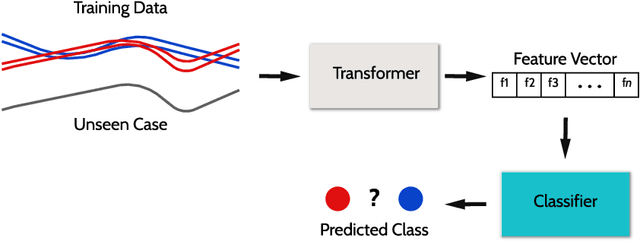
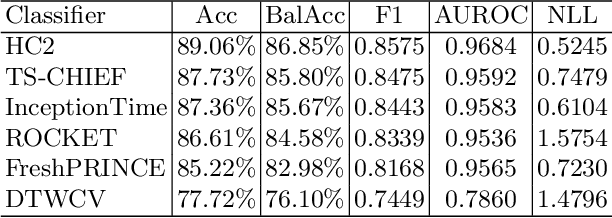
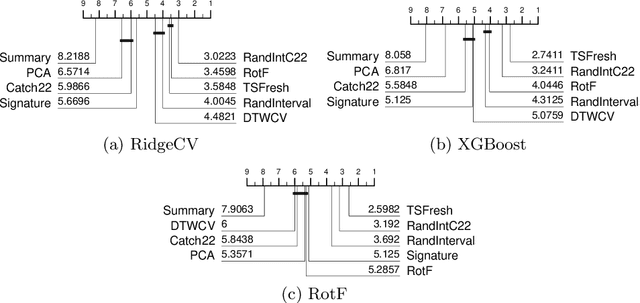

Abstract:There have recently been significant advances in the accuracy of algorithms proposed for time series classification (TSC). However, a commonly asked question by real world practitioners and data scientists less familiar with the research topic, is whether the complexity of the algorithms considered state of the art is really necessary. Many times the first approach suggested is a simple pipeline of summary statistics or other time series feature extraction approaches such as TSFresh, which in itself is a sensible question; in publications on TSC algorithms generalised for multiple problem types, we rarely see these approaches considered or compared against. We experiment with basic feature extractors using vector based classifiers shown to be effective with continuous attributes in current state-of-the-art time series classifiers. We test these approaches on the UCR time series dataset archive, looking to see if TSC literature has overlooked the effectiveness of these approaches. We find that a pipeline of TSFresh followed by a rotation forest classifier, which we name FreshPRINCE, performs best. It is not state of the art, but it is significantly more accurate than nearest neighbour with dynamic time warping, and represents a reasonable benchmark for future comparison.
The Temporal Dictionary Ensemble (TDE) Classifier for Time Series Classification
May 09, 2021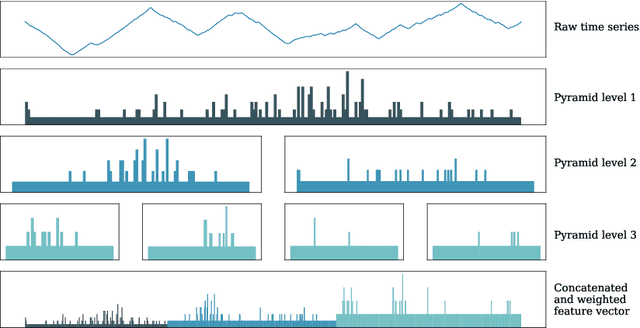


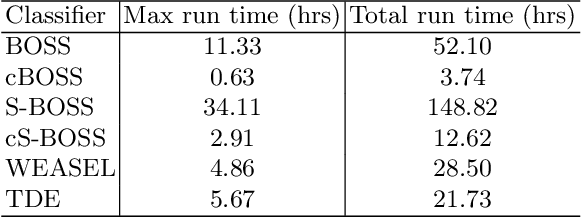
Abstract:Using bag of words representations of time series is a popular approach to time series classification. These algorithms involve approximating and discretising windows over a series to form words, then forming a count of words over a given dictionary. Classifiers are constructed on the resulting histograms of word counts. A 2017 evaluation of a range of time series classifiers found the bag of symbolic-fourier approximation symbols (BOSS) ensemble the best of the dictionary based classifiers. It forms one of the components of hierarchical vote collective of transformation-based ensembles (HIVE-COTE), which represents the current state of the art. Since then, several new dictionary based algorithms have been proposed that are more accurate or more scalable (or both) than BOSS. We propose a further extension of these dictionary based classifiers that combines the best elements of the others combined with a novel approach to constructing ensemble members based on an adaptive Gaussian process model of the parameter space. We demonstrate that the temporal dictionary ensemble (TDE) is more accurate than other dictionary based approaches. Furthermore, unlike the other classifiers, if we replace BOSS in HIVE-COTE with TDE, HIVE-COTE is significantly more accurate. We also show this new version of HIVE-COTE is significantly more accurate than the current best deep learning approach, a recently proposed hybrid tree ensemble and a recently introduced competitive classifier making use of highly randomised convolutional kernels. This advance represents a new state of the art for time series classification.
* arXiv admin note: text overlap with arXiv:1911.12008
HIVE-COTE 2.0: a new meta ensemble for time series classification
Apr 15, 2021


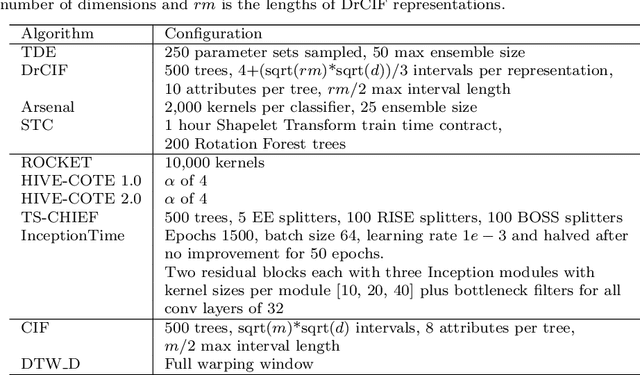
Abstract:The Hierarchical Vote Collective of Transformation-based Ensembles (HIVE-COTE) is a heterogeneous meta ensemble for time series classification. HIVE-COTE forms its ensemble from classifiers of multiple domains, including phase-independent shapelets, bag-of-words based dictionaries and phase-dependent intervals. Since it was first proposed in 2016, the algorithm has remained state of the art for accuracy on the UCR time series classification archive. Over time it has been incrementally updated, culminating in its current state, HIVE-COTE 1.0. During this time a number of algorithms have been proposed which match the accuracy of HIVE-COTE. We propose comprehensive changes to the HIVE-COTE algorithm which significantly improve its accuracy and usability, presenting this upgrade as HIVE-COTE 2.0. We introduce two novel classifiers, the Temporal Dictionary Ensemble (TDE) and Diverse Representation Canonical Interval Forest (DrCIF), which replace existing ensemble members. Additionally, we introduce the Arsenal, an ensemble of ROCKET classifiers as a new HIVE-COTE 2.0 constituent. We demonstrate that HIVE-COTE 2.0 is significantly more accurate than the current state of the art on 112 univariate UCR archive datasets and 26 multivariate UEA archive datasets.
 Add to Chrome
Add to Chrome Add to Firefox
Add to Firefox Add to Edge
Add to Edge